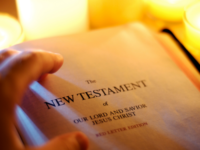
In the Bible, particularly in the Old Testament, the comparison of humans to sheep is a metaphor used to convey various aspects of the relationship between people and God. This metaphor is employed in both the Old and New Testaments and serves to illustrate certain characteristics and dynamics.
Dependence on a Shepherd (God):
In many instances, humans are likened to sheep to emphasize their dependence on a shepherd. This shepherd is often seen as a representation of God. The idea is that, like sheep need a shepherd for guidance, provision, and protection, humans depend on God for these aspects in their lives.
Psalm 23:1 (NIV): “The Lord is my shepherd, I lack nothing.”
Vulnerability and Straying:
Sheep are known for their tendency to wander and get lost. Similarly, the Bible uses the image of sheep to illustrate human vulnerability and the tendency to stray from God’s guidance.
Isaiah 53:6 (NIV): “We all, like sheep, have gone astray, each of us has turned to our own way; and the Lord has laid on him the iniquity of us all.”
Guidance and Direction:
The shepherd/sheep metaphor is also employed to emphasize the need for divine guidance. In this context, humans are portrayed as needing God’s direction in their lives, just as sheep need a shepherd to lead them to safe pastures.
Psalm 119:176 (NIV): “I have strayed like a lost sheep. Seek your servant, for I have not forgotten your commands.”
Care and Protection:
The imagery of sheep highlights the care and protection that God provides for His people. The shepherd is responsible for the well-being of the flock, and in a similar way, God is portrayed as the caring and protective figure for humans.
John 10:11 (NIV): “I am the good shepherd. The good shepherd lays down his life for the sheep.”
These biblical comparisons serve as metaphors to convey spiritual truths and the relational dynamics between God and humanity. The intention is not to diminish human dignity but rather to illustrate the need for a loving, guiding, and protective relationship with God.
- John F. Kennedy: “The shepherd always tries to persuade the sheep that their interests and his own are the same.”
- Dwight D. Eisenhower: “You do not lead by hitting people over the head; that’s assault, not leadership. The leader is best when people barely know he exists when his work is done, his aim fulfilled; they will say, ‘We did it ourselves.'”
- Albert Schweitzer: “Example is not the main thing in influencing others. It is the only thing.”
- Dolly Parton: “I’m not offended by all the dumb blonde jokes because I know I’m not dumb… and I also know that I’m not blonde.”
FAQ:
Why are humans compared to sheep in the Bible?
The comparison of humans to sheep in the Bible serves as a metaphor to convey various aspects of the relationship between people and God.
What does the comparison emphasize?
The metaphor emphasizes the dependence of humans on God, similar to how sheep depend on a shepherd for guidance, provision, and protection.
What biblical passages use this metaphor?
Passages such as Psalm 23, Isaiah 53:6, and John 10:11 use the shepherd/sheep metaphor to convey spiritual truths.
What does the metaphor say about human vulnerability?
The comparison highlights human vulnerability and the tendency to stray from God’s guidance, akin to how sheep may wander.
How does the metaphor illustrate divine care?
The imagery of sheep underscores the care and protection that God provides for His people, portraying God as a loving and protective shepherd.
Is the purpose to diminish human dignity?
No, the intention is not to diminish human dignity but to illustrate the need for a loving, guiding, and protective relationship with God.
What themes does the metaphor cover?
The metaphor covers themes of dependence, guidance, vulnerability, and the caring nature of God in the lives of humans.
Does this metaphor appear in both the Old and New Testaments?
Yes, the shepherd/sheep metaphor is present in both the Old and New Testaments, emphasizing its significance in biblical imagery.












Leave a Reply